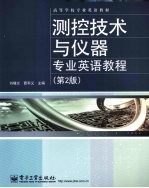

测控技术与仪器专业英语教程 第2版PDF电子书下载
- 电子书积分:12 积分如何计算积分?
- 作 者:刘曙光编著
- 出 版 社:北京:电子工业出版社
- 出版年份:2009
- ISBN:9787121093296
- 页数:350 页
Lesson 1 Periodic Signals 1
1.1 Time-Domain Description 1
1.2 Frequency-Domain Description 2
1.3 Orthogonal Functions 3
1.4 The Fourier Series 5
Exercises 12
Reading Material:Underwater Acoustic Signal 13
Lesson 2 Aperiodic Signal 16
2.1 Introduction 16
2.2 The Exponential Form of the Fourier Series 16
2.3 The Fourier Transform 17
2.4 The Laplace Transform 24
Exercises 31
Reading Material:Properties of Signal and Noise 32
Lesson 3 Sampled-Data Signals 35
3.1 Introduction 35
3.2 Mathematical Description Using the Dirac Function 35
3.3 Spectra of Sampled-data Signals 37
3.4 The z-transform 39
Exercises 46
Reading Material:Signal Sampling 48
Lesson 4 Random Signals 52
4.1 Introduction 52
4.2 Elements of Probability Theory 54
4.3 Amplitude Distribution and Moments 59
4.4 The Autocorrelation and Power Spectral Density 61
Exercises 68
Reading Material:The Processing of Random Signal 69
Lesson 5 Static Performance 74
5.1 The Ideal Measuring System 74
5.2 Sensitivity 74
5.3 Accuracy and Precision 76
5.4 Possible and Probable Errors 77
5.5 Other Static-Performance Terms 77
Exercises 79
Reading Material:Noncontact Temperature Measurement 81
Lesson 6 Dynamic Performance 84
6.1 Zero-order Systems 85
6.2 First-order Systems 85
6.3 Second-order Systems 89
6.4 Step-response Specification 93
6.5 Frequency-response Specification 94
Exercises 97
Reading Material:Eddy Current 98
Lesson 7 Basic Knowledge of Transducers and Resistance Transducers 101
7.1 Transducer Elements 101
7.2 Transducer Sensitivity 101
7.3 Characteristics of an Ideal Transducer 102
7.4 Electrical Transducers 103
7.5 Resistance Transducers 103
Exercises 113
Reading Material:Laser 114
Lesson 8 Capacitance,Inductance Transducers and Some Others 117
8.1 Capacitive Transducers 117
8.2 Inductive Transducers 118
8.3 Linear Variable-differential Transformer(l.v.d.t.) 120
8.4 Piezo-electric Transducers 121
8.5 Electromagnetic Transducers 122
8.6 Thermoelectric Transducers 123
8.7 Photoelectric Cells(self-generating) 124
8.8 Mechanical Transducers and Sensing Elements 124
Exercises 129
Reading Material:Video Camera 130
Lesson 9 Analog Instruments 134
9.1 Meter Basics 134
9.2 Ammeters 136
9.3 Current Measuring Errors 137
9.4 DC Voltmeters 139
9.5 Voltage Measuring Errors 141
9.6 Ohmmeter and Resistance Measurements 143
9.7 Series Ohmmeter 143
9.8 Shunt Ohmmeter 145
9.9 Ohmmeter Accuracy 146
9.10 Volt-Ohm-Milliammeters 147
9.11 Electronic Voltmeters 148
9.12 Transistorized Electronic Voltmeters 149
9.13 FET Voltmeters 151
9.14 Operational Amplifier Electronic Voltmeters 152
9.15 Electronic Current Measurements 154
9.16 Resistance Measurements 155
Exercises 160
Reading Material:Rectifier Meters 161
Lesson 10 Digital Instruments 166
10.1 Digital Displays 166
10.2 Electronic Digital Counter 168
10.3 Input Signal Conditioning 169
10.4 Timerbase Oscillator 171
10.5 Timerbase Dividers 173
10.6 Counting Register 173
10.7 Digital Voltmeter 179
Exercises 182
Reading Material:Rise-time Measurements 183
Lesson 11 Computer-based Test Instruments 187
11.1 Internal Adapters 187
11.2 External PC Instruments 189
11.3 Analog-to-Digital Conversion 192
11.4 Computer Interface 196
11.5 General-purpose Interface BUS 196
Exercises 201
Reading Material:PC-based Workstation 202
Lesson 12 Electronics 207
12.1 Introduction 207
12.2 Historical Background 207
12.3 Electronic Components 208
Exercises 213
Reading Material:Electronic Circuits 214
Lesson 13 Microprocessor 218
13.1 Introduction 218
13.2 Computer Memory 218
13.3 Microcontroller 219
13.4 Semiconductors 219
13.5 Transistors 220
13.6 Construction of Microprocessors 220
13.7 History of the Microprocessor 222
13.8 Future Technology 222
Exercises 225
Reading Material:Number Systems 227
Lesson 14 Remote Sensing 230
14.1 Sensors 230
14.2 Satellites 231
14.3 Outlook 231
Exercises 233
Reading Material:GPS 234
Lesson 15 Multi-sensor Data Fusion 237
15.1 Introduction 237
15.2 Technical Background 237
15.3 Method 238
15.4 Application 239
Reading Material:Multi-sensor Image Fusion 248
Lesson 16 Nanotechnology 251
16.1 Nanotechnology 251
16.2 Material Technology 251
16.3 Precision Machining and Materials Processing 252
16.4 Applications 254
Reading Material:Micro-machine 260
参考译文 265
第1课 周期信号 265
第2课 非周期信号 270
第3课 数据采样信号 278
第4课 随机信号 285
第5课 静态性能 293
第6课 动态性能 296
第7课 传感器和电阻式传感器的基础知识 302
第8课 电容式、电感式传感器及其他 307
第9课 模拟仪器 312
第10课 数字仪器 324
第11课 基于计算机的测试仪器 330
第12课 电子学 335
第13课 微处理器 337
第14课 遥感 341
第15课 多传感器数据融合 342
第16课 纳米技术 345
参考文献 350
- 《电子测量与仪器》人力资源和社会保障部教材办公室组织编写 2009
- 《高级英语阅读与听说教程》刘秀梅编著 2019
- 《看图自学吉他弹唱教程》陈飞编著 2019
- 《激光加工实训技能指导理实一体化教程 下》王秀军,徐永红主编;刘波,刘克生副主编 2017
- 《AutoCAD 2019 循序渐进教程》雷焕平,吴昌松,陈兴奎主编 2019
- 《少儿电子琴入门教程 双色图解版》灌木文化 2019
- 《中央财政支持提升专业服务产业发展能力项目水利工程专业课程建设成果 设施农业工程技术》赵英编 2018
- 《Photoshop CC 2018基础教程》温培利,付华编著 2019
- 《“十三五”规划教材 中药鉴定学实验 供中药学 药学及相关专业使用 第2版》吴啟南 2018
- 《剑桥国际英语写作教程 段落写作》(美)吉尔·辛格尔顿(Jill Shingleton)编著 2019
- 《市政工程基础》杨岚编著 2009
- 《家畜百宝 猪、牛、羊、鸡的综合利用》山西省商业厅组织技术处编著 1959
- 《《道德经》200句》崇贤书院编著 2018
- 《高级英语阅读与听说教程》刘秀梅编著 2019
- 《计算机网络与通信基础》谢雨飞,田启川编著 2019
- 《看图自学吉他弹唱教程》陈飞编著 2019
- 《法语词汇认知联想记忆法》刘莲编著 2020
- 《培智学校义务教育实验教科书教师教学用书 生活适应 二年级 上》人民教育出版社,课程教材研究所,特殊教育课程教材研究中心编著 2019
- 《国家社科基金项目申报规范 技巧与案例 第3版 2020》文传浩,夏宇编著 2019
- 《流体力学》张扬军,彭杰,诸葛伟林编著 2019
- 《电子测量与仪器》人力资源和社会保障部教材办公室组织编写 2009
- 《少儿电子琴入门教程 双色图解版》灌木文化 2019
- 《指向核心素养 北京十一学校名师教学设计 英语 七年级 上 配人教版》周志英总主编 2019
- 《北京生态环境保护》《北京环境保护丛书》编委会编著 2018
- 《指向核心素养 北京十一学校名师教学设计 英语 九年级 上 配人教版》周志英总主编 2019
- 《通信电子电路原理及仿真设计》叶建芳 2019
- 《高等院校旅游专业系列教材 旅游企业岗位培训系列教材 新编北京导游英语》杨昆,鄢莉,谭明华 2019
- 《电子应用技术项目教程 第3版》王彰云 2019
- 《中国十大出版家》王震,贺越明著 1991
- 《近代民营出版机构的英语函授教育 以“商务、中华、开明”函授学校为个案 1915年-1946年版》丁伟 2017
